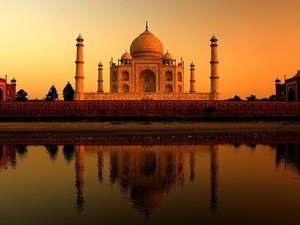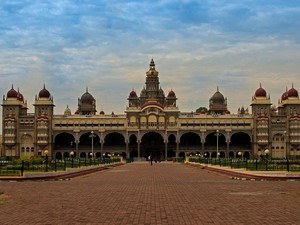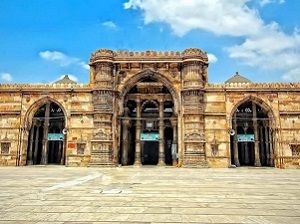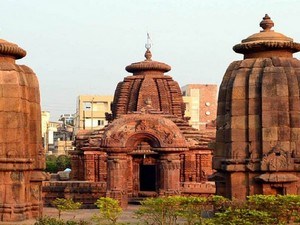1
DAY 1 : JAIPUR SIGHTSEEING
DAY 1 : JAIPUR SIGHTSEEING
 Sightseeing
Sightseeing
Leisure / No Sightseeing
At a distance of 13 km from Jaipur Junction Railway Station, Amer Fort or Amber Fort is located in Amer near Jaipur. It is one of the best-preserved forts in Rajasthan, and among the prime place to include in Jaipur packages.
Amber was founded by the Meenas in 967 AD and they dedicated the town to Amba, the Mother Goddess. Around 1037 AD, Amber was conquered by Kachhawa Rajputs and ruled from the 11th to the 18th century, until the capital was moved from Amer to Jaipur. The Amber Fort was built by Raja Man Singh in 1592 AD and it was further expanded by successive rulers. Man Singh was one of the trusted generals of Emperor Akbar and one among the Navaratnas of his court. Later in 1727 AD, Sawai Jai Singh II moved the capital from Amber to Jaipur.
The architecture of Amer Fort is influenced by both Hindu and Muslim styles. Among the famous tourist places in Jaipur, Amer .....
 Duration of visit: 2 Hours
Duration of visit: 2 Hours
 Timings: Timings: 8 AM to 5.30 PM
Timings: Timings: 8 AM to 5.30 PM
At a distance of 15 km from Jaipur Junction Railway Station and less than 1 km (by walk) from Amer Fort, Jaigarh Fort is situated on a cliff called Cheel ka Teela (Hill of Eagles) of the Aravali range. It overlooks the Amber Fort and the Maota Lake. This is one of the best forts in Jaipur and also among the famous Jaipur tourist places which is commonly visited from Amber Fort.
The fort was built by Jai Singh II in 1726 to protect the Amber Fort and was named after him. Amer was once known as Dhundhar, the old and original fort of Amer was ruled by clan of Meenas and later it was ruled by Kacchwa Rajputs. The Jaigarh fort was actually a defensive structure rather than a palace. Jaigarh Fort and Amber Fort are connected by underground passages.
The Jaigarh Fort is similar in structural design to the Amer Fort. It has a length of 3 km and width of 1 km. .....
 Duration of visit: 1-2 Hours
Duration of visit: 1-2 Hours
 Timings: 9 AM to 4.30 PM
Timings: 9 AM to 4.30 PM
At a distance of 11 km from Jaipur Junction Railway Station and 8 km from Amer Fort, Jal Mahal or the Water Palace is a palace located in the middle of the Man Sagar Lake in Jaipur. This is one of the biggest artificial lakes in Jaipur. The lake used to be a bird watcher's paradise in the past and was a favorite ground for the Rajput kings of Jaipur for royal duck shooting parties during picnics.
Jal Mahal was built in 18th century by Sawai Madho Singh I. Jal Mahal was constructed for serving the purpose of a summer resort for his family and guests. The palace was renovated and expanded in the 18th century by Madho Singh II. The Jal Mahal palace is considered an architectural beauty built in the Rajput and Mughal styles of architecture. It provides a picturesque view of the lake from the Man Sagar Dam and the surrounding Nahargarh hills. The palace was built using red sandstone. It is a five storied building out of which four floors remain under water when the lake is full and the .....
 Duration of visit: 30 Mins - 1 Hr
Duration of visit: 30 Mins - 1 Hr
 Timings: 9 AM to 5 PM
Timings: 9 AM to 5 PM
At a distance of 7 km from Jaipur Junction Railway Station and 7 km from Amer Fort, Maharaja ki Chhatri, also known as Gaitor Tombs are located in the walled city area named Brahmpuri at the foothills of Nahargarh Fort on Jaipur-Amer road. Gaitor is the cremation ground of the Royal Maharajas of Rajasthan.
It is believed that the word Gaitor is the mispronunciation form of Gaye ka Thor that means the resting place of the departed souls. Royal cenotaphs are built over the cremation site. The carving on each cenotaph is a reflection of the taste of the respective Maharajas.
These cenotaphs are a perfect collaboration of Islamic and Hindu architecture. The cenotaphs at Gaitor are in the form of open pavilions along with ornate domes that are supported by intricately sculpted pillars. The decor and profusion of each Chattri shows the stature and mastery of a particular king. Maharajas Pratap Singh, Madho Singh II and Jai Singh II, among others, are honoured here. The cenotaph .....
 Duration of visit: 30 Mins
Duration of visit: 30 Mins
 Timings: 10 AM to 5.30 PM
Timings: 10 AM to 5.30 PM
At a distance of 11 km from Jaipur Junction Railway Station, Khole Ke Hanuman Ji is an ancient temple situated at Laxman Dungri in Jaipur. This temple is considered to be one of the famous temples in Jaipur, and among the must include places in Jaipur tour packages.
Khole Ke Hanuman ji Temple is dedicated to the Lord Hanuman. The inner sanctum of the temple is quite large and can accommodate 500 devotees. The temple is situated on a hillock and devotees have to walk around 1 km to reach the temple. The temple has an attractive entrance archway. The temple is known for its magical power and it is believed that the wishes of the devotees are always fulfilled. It is one of the popular Jaipur places to visit, especially for religious people.
The natural view of Aravali hill is magnificent from the temple and surrounding places. A large number of tourists .....
 Duration of visit: 1 Hour
Duration of visit: 1 Hour
 Timings: 6 AM to 8.30 PM
Timings: 6 AM to 8.30 PM
2
DAY 2 : JAIPUR SIGHTSEEING & TRAVEL TO RANTHAMBHORE
%%Itinerary_Title_Day2%%
At a distance of 5.5 km from Jaipur Junction Railway Station, City Palace is a beautiful palace complex situated in the heart of Jaipur City. It is one of the popular palaces in Rajasthan, and among the famous places to visit as part of Jaipur tour.
The palace was built between 1729 and 1732 AD by Sawai Jai Singh II. He planned and built the outer walls and later additions were made by successive rulers till the end of the 20th century. City Palace was the seat of the Maharaja of Jaipur, the head of the Kachhwa Rajput clan. Part of the palace currently houses a museum, though the major part is still a royal residence. It one of the most famous Jaipur tourist places.
The City Palace reflects Rajput, Mughal, and European architectural styles although it was designed according to Vaastushastra. The Palace .....
 Duration of visit: 1-2 Hours
Duration of visit: 1-2 Hours
 Timings: 9 AM to 5 PM
Timings: 9 AM to 5 PM
At a distance of 5.5 km from Jaipur Junction Railway Station, Jantar Mantar is located near City Palace and Hawa Mahal in Jaipur. It is one of the top tourist places in Jaipur City. This monument is the largest of the five astronomical observatories present in India. The other four astronomical observatories are located at Delhi, Varanasi, Mathura and Ujjain. It features the world's largest stone sundial, and is a UNESCO World Heritage site.
The Jantar Mantar was built by the Rajput king Sawai Jai Singh II and completed in 1738 AD. The name is derived from jantar means yantra and mantar means calculation. The Jaipur observatory was functional for seven years only, as the Maharaja was not very successful in deriving accurate, astronomical observations. It was later restored in the year 1901 and was declared as a national monument in the year 1948.
The .....
 Duration of visit: 30 Mins - 1 Hr
Duration of visit: 30 Mins - 1 Hr
 Timings: 9:30 AM to 4:30 PM
Timings: 9:30 AM to 4:30 PM
At a distance of 6 km from Jaipur Junction Railway Station, Hawa Mahal is one of the prime tourist places to visit in Jaipur city. The palace sits on the edge of the City Palace and extends to the Zenana (women's) chambers. Hawa Mahal is often represented in promotion of Jaipur Tourism. Jaipur is among the top places to visit near Delhi.
The renowned Hawa Mahal or the Palace of Winds was constructed in 1799 by Maharaja Sawai Pratap Singh as a continuation to the stunning City Palace. The main architect of this palace is Lal Chand Ustad and the palace is believed to have been constructed in the form of the crown of Krishna, the Hindu God.
Hawa Mahal was built in Rajputana architectural style. The palace is constructed of beautiful red and pink sandstone and it looks like a five storeyed Pyramid. The palace stands on a podium which is fifty .....
 Duration of visit: 30 Mins
Duration of visit: 30 Mins
 Timings: 9 AM to 4.30 PM
Timings: 9 AM to 4.30 PM
At a distance of 6 km from Jaipur Junction Railway Station, Albert Hall Museum is a museum situated in Ram Niwas Garden outside the city wall opposite the new gate in Jaipur. It is the oldest museum in Rajasthan, and one of the popular places of sightseeing in Jaipur.
The Albert Hall Museum is functioning as the State Museum of Rajasthan. The Hall was built by Maharaja Sawai Ram Singh II. The foundation stone of Albert Hall was laid during the visit of the Prince of Wales, Albert Edward to Jaipur in 1876 and it was completed in 1887. The building was designed by Sir Samuel Swinton Jacob and was opened as a public museum in 1887. It is also called the Government Central Museum. Maharaja Ram Singh initially wanted this building to be a town hall, but his successor, Madho Singh II, decided it should be a museum for the art of Jaipur.
It is a fine example of Indo-European architecture. The design of .....
 Duration of visit: 1-2 Hours
Duration of visit: 1-2 Hours
 Timings: 9 AM to 5 PM on all days. Closed on Friday
Timings: 9 AM to 5 PM on all days. Closed on Friday
BREAK FOR MEALS / HOTEL CHECK-IN | CHECK-OUT / SHOPPING / LEISURE
At a distance of 6 km from Jaipur Junction Railway Station, Birla Mandir is a Hindu temple located at the base of Moti Dongri Hill in Jaipur. The temple is sometimes also referred to as the Laxmi Narayan Temple. It is one of the major places to visit in Jaipur.
This marvelous temple was built during the year 1988 by Birla Group of Industries, one of the business tycoons of India. According to history, the Birla temple was built on the land given to the Birla family by the Maharaja.
The Temple is dedicated to Lord Vishnu (Narayan) and his consort Lakshmi. The images of Lakshmi and Narayan attract the attention, being made out from one piece of marble. Standing on a raised platform, Birla Temple is made out with the premium quality of white marble. The temple looks stunning, when it is brightly lit in the night. The three huge domes of the temple represent three different approaches to the religion. .....
 Duration of visit: 1 Hour
Duration of visit: 1 Hour
 Timings: 6 AM - 12 PM & 3 PM - 8:30 PM
Timings: 6 AM - 12 PM & 3 PM - 8:30 PM
3
DAY 3 : RANTHAMBHORE SIGHTSEEING & TRAVEL TO JAIPUR
%%Itinerary_Title_Day2%%
At a distance of 8 km from Sawai Madhopur, 140 km from Kota, 162 km from Jaipur, 268 km from Agra, 271 km from Ajmer, 368 km from Delhi, 413 km from Udaipur, and 448 km from Jodhpur, Ranthambore National Park is situated in the Sawai Madhopur district of Rajasthan. It is one of the largest and most renowned national parks in India, and among the must include places in Rajasthan tour packages.
Ranthambhore was established as the Sawai Madhopur Game Sanctuary in 1955 by the Government of India and was declared one of the Project Tiger reserves in 1974. Ranthambore became a national park in 1981. In 1984, the adjacent forests were declared the Sawai Man Singh Sanctuary and Keladevi Sanctuary, and in 1991 the tiger reserve was enlarged to include the Sawai Man Singh and Keladevi sanctuaries. It is one of the major tourist places near Jaipur.
Among .....
 Duration of visit: 4 Hours/Half Day
Duration of visit: 4 Hours/Half Day
 Timings: Safari Timings: 6.30 - 9.30AM &3.30 PM - 6.30 PM in summer, 7 AM - 10.30 AM & 2.30 PM - 6 PM in wint
Timings: Safari Timings: 6.30 - 9.30AM &3.30 PM - 6.30 PM in summer, 7 AM - 10.30 AM & 2.30 PM - 6 PM in wint





















